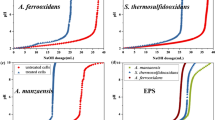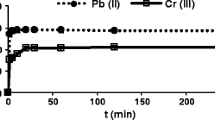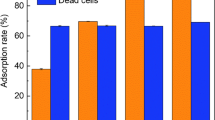Abstract
The contribution of various cell-surface components to Cu2+ adsorption by a Gram-negative bacterium, Pseudomonas putida 5-x, that was isolated from local electroplating effluent with a high capability to accumulate heavy metal ions was studied. The cell superficial layer had a negative effect on Cu2+ adsorption of the bacterial cells. Cu2+ adsorption capacity of the separated cell envelopes was fivefold more than that of the intact cells, owing to the liberation of more and more binding sites during the separation process. Some main components in the cell envelope, such as the peptidoglycan (PEG) layer, outer membrane, and inner membrane, provide the capability for Cu2+ adsorption. The content of the components in the cell envelope is in the order inner membrane > outer membrane > PEG layer, and their Cu2+ adsorption capacity was in the order PEG layer > outer membrane > inner membrane. The total contribution of the separated PEG layer material to Cu2+ adsorption by the cell envelope was no more than 15%, and the outer membrane and inner membrane contributed about 30–35% and 25–30%, respectively. The relatively high phospholipid content in the outer membrane may be the major reason for the higher adsorption capacity of the outer membrane to Cu2+ and, hence, such a high Cu2+ adsorption capacity of P. putida 5-x cell envelope.
Similar content being viewed by others
References
James, A. M. (1982), Adv. Colloid Interface Sci. 15, 171–221.
Doyle, R. J., Matthews, T. H., and Streips, U. N. (1980), J. Bacteriol. 143, 471–480.
Beveridge, T. J., Forsberg, C. W., and Doyle, R. J. (1982), J. Bacteriol. 150, 1438–1448.
Wong, P. K. and So, C. M. (1993), Microbiology 73, 113–131.
Kratochvil, D. and Volesky, B. (1998), Trends Biotechnol. 16, 291–301.
Warren, L. A. and Ferris F. G. (1998), Environ. Sci. Technol. 32, 2331–2337.
Yetis, U. E., Oezcengiz, G., Dilek, F. B., Ergen, N., Erbay, A., and Doelek, A. (1998), Water Sci. Technol. 38, 323–330.
Mameri, N., Boudries, N., and Addour, L. (1999), Water Res. 33, 1347–1354.
Gutnick, D. L. and Bach, H. (2000), Appl. Microbiol. Biotechnol. 54, 451–460.
Remacle, J. (1993), in Biosorption of Heavy Metals, Volesky, B., ed., CRC Press, Boca Raton, FL, pp. 83–93.
Beveridge, T. J. (1986), in Biotechnology for the Mining, Metal-Refining, and Fossil Fuel Processing Industries, Ehrlich, H. L. and Holmes, D. S., eds., Wiley Interscience, New York, pp. 127–161.
McLean, R. J. and Beveridge, T. J. (1990), in Microbial Mineral Recovery, Ehrlich, H. L. and Brierley, C. L., eds., McGraw-Hill, New York, pp. 303–324.
Beveridge, T. J. and Fyfe, W. S. (1985), Can. J. Earth Sci. 22, 1893–1898.
Brierley, C. L. (1990), in Microbial Mineral Recovery, Ehrlich, H. L. and Brierley, C. L., eds., McGraw-Hill, New York, pp. 325–333.
Beveridge, T. J. and Koval, S. F. (1981), Appl. Environ. Microbiol. 42, 325–335.
Hoyle, B. and Beveridge, T. J. (1983), Appl. Environ. Microbiol. 46, 749–751.
Fall, J. and Block, J. C. (1993), FEMS Microbiol. Lett. 108, 347–352.
Ferris, F. G. and Beveridge, T. J. (1984), FEMS Microbiol. Lett. 24, 43–51.
Sze, K. F., Lu, Y. J., and Wong, P. K. (1996), Resour. Conser. Recycl. 18, 175–193.
Wang, L., Chua, H., Wong, P. K., Lo, W. H., Yu, H. F., and Zhao, Y. G. (2000), Water Sci. Technol. 41, 241–246.
Geesey, G. G. and Jang, L. (1989), in Metal Ions and Bacteria, Doyle, T. J. and Beveridge, R. J., eds., John Wiley & Sons, New York, pp. 325–357.
Schnaitman, C. A. (1970), J. Bacteriol. 104, 890–901.
Kropinski, A. M., Lewis, B. V., and Berry, D. J. (1987), Bacteriology 169, 1960–1966.
Weidel, W. and Peltzer, H. (1964), Adv. Enzymol. 26, 193–232.
Lowry, O. H., Rosebrough, X. J., Farr, A. L., and Randall, R. J. (1951), Anal. Biochem. 59, 265–275.
Hanahan, D. J. A. (1996), Guide to Phospholipid Chemistry, Oxford University Press, New York, pp. 95–119.
Osborn, M. J., Gander, J. E., Parisi, E., and Carson, J. (1972), J. Biol. Chem. 247, 3962–3972.
Work, E. (1957), Biochem. J. 67, 417–423.
Karkhanis, Y. D., Zeltner, J. K., and Jackson, J. J. (1978), Anal. Biochem. 85, 595–601.
Hu, Z. C., Norman, J. M., Faison, B. D., and Reeres, M. E. (1996), Biotechnol. Bioeng. 51, 237–247.
Sag, Y. and Kutsal, T. (1995), Chem. Eng. J. 60, 181–188.
Atkinson, B. W., Bux, F. H., and Kasan, C. (1998), Water SA 24, 129–135.
Gadd, G. M. (1988), in Biotechnology—A Comprehensive Treatise in 8 Volumes, Volume 6B, Rehm, H. J. and Reed, G., eds., VCH, Weinheim, pp. 195–231.
Yee, N. and Fein, J. (2001), Geochim. Cosmochim. Acta 65, 2037–2042.
Schiewer, S. and Volesky, B. (2000), in Environmental Microbe-Metal Interactions, Derek, R. L., ed., ASM Press, Washington, DC, pp. 329–362.
Bobo, R. A. and Eagon, R. G. (1968), Can. J. Microbiol. 14, 503–513.
Bhakoo, M. and Herbert, R. A. (1980), Arch. Microbiol. 126, 51–55.
Rogers, S. W., Gilleland, H. E., and Eagon, R. G. (1980), Can. J. Microbiol 15, 743–748.
Wilkinson, S. G., Galbrath, L., and Lightfoot, G. A. (1969), Eur. J. Biochem. 33, 158–174.
Author information
Authors and Affiliations
Corresponding author
Rights and permissions
About this article
Cite this article
Wang, L., Li, F.T. & Zhou, Q. Contribution of cell-surface components to Cu2+ adsorption by Pseudomonas putida 5-x. Appl Biochem Biotechnol 128, 33–46 (2006). https://doi.org/10.1385/ABAB:128:1:033
Received:
Revised:
Accepted:
Issue Date:
DOI: https://doi.org/10.1385/ABAB:128:1:033




